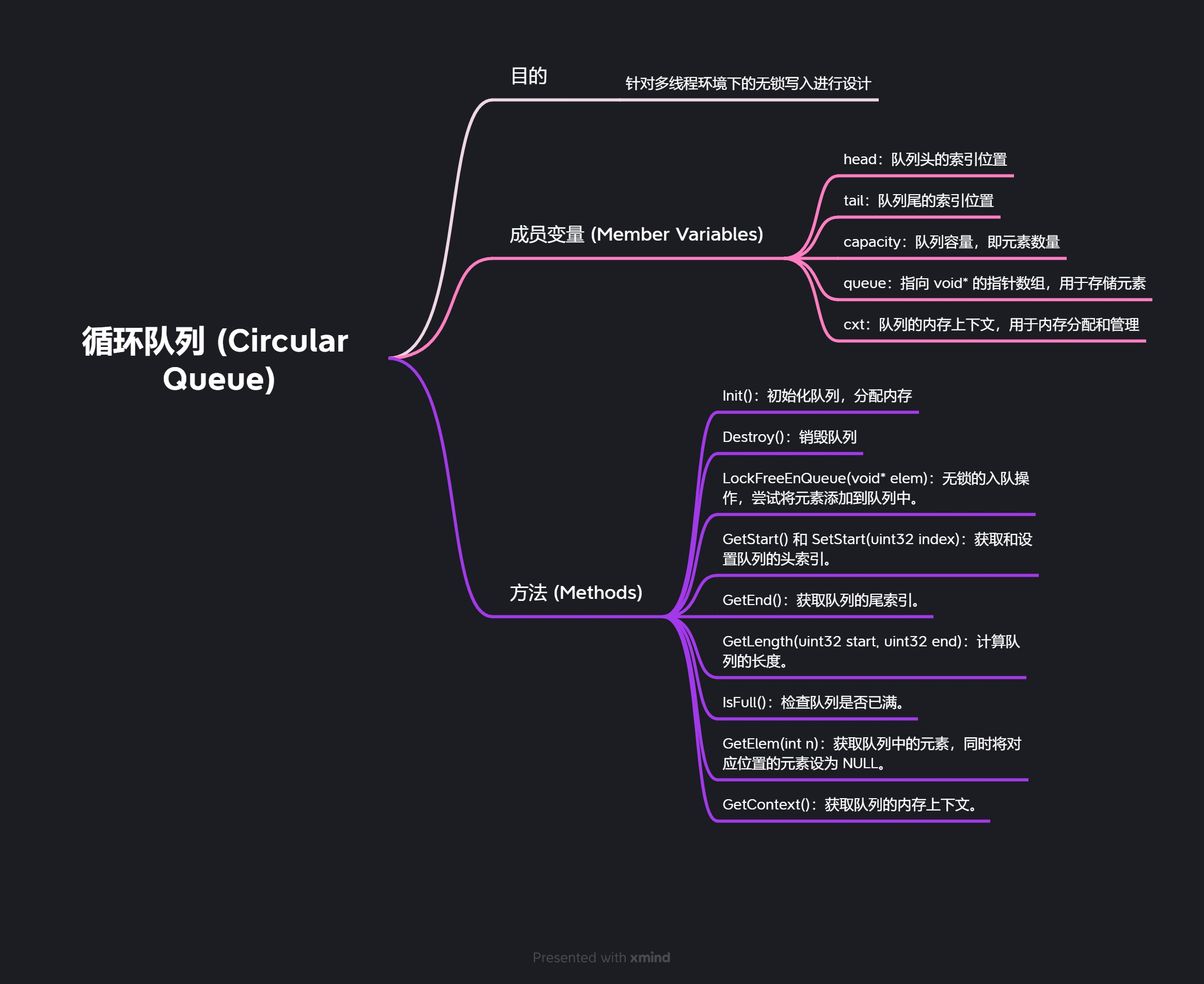对circularqueue.cpp的分析
引言
该文件是典型的C++文件,circularqueue即循环队列。循环队列是一个重要的数据结构,它具有高效的时间复杂度,如插入和删除操作的时间复杂度为 O(1),其中 n 是队列中元素的数量。该文章继承于上篇对于circularqueue.h的分析,两篇博客建议对照阅读。
代码
const int SIZE_OF_UINT64 = 8;
const int SIZE_OF_TWO_UINT64 = 16;
/* lock free circular queue for writing */
CircularQueue::CircularQueue(int size, MemoryContext context)
: head(0), tail(0), capacity(size), queue(NULL), cxt(context) // cxt is the context of the queue
{
}
CircularQueue::~CircularQueue() {
}
void CircularQueue::Init() {
MemoryContext oldcxt = MemoryContextSwitchTo(cxt); // switch to the context of the queue
queue = (void**)palloc0(sizeof(void*) * capacity); // allocate memory for the queue
(void)MemoryContextSwitchTo(oldcxt); // switch back to the old context
}
void CircularQueue::Destroy() {
for (uint32 i = 0; i < capacity; i++) {
CleanHotkeyInfo((HotkeyInfo*)queue[i]); // clean the hotkey info
}
pfree_ext(queue); // free the memory of the queue
cxt = NULL; // set the context of the queue to NULL
}
bool CircularQueue::LockFreeEnQueue(void* elem) {
while (true) {
uint32 valid_slot = tail; // get the tail of the queue
uint32 update_tail = (valid_slot + 1) % capacity; // get the next tail of the queue
if (IsFull()) { // if the queue is full, return false
return false;
}
if (!pg_atomic_compare_exchange_u32(&tail, &valid_slot, update_tail)) {
continue; // if the tail of the queue is changed, continue
} else {
Assert(queue[valid_slot] == NULL); // the slot should be NULL
queue[valid_slot] = elem; // set the element to the slot
return true;
}
}
}
const uint32 CircularQueue::GetStart() const {
return head; // get the head of the queue
}
void CircularQueue::SetStart(uint32 index) {
head = index % capacity; // set the head of the queue
}
const uint32 CircularQueue::GetEnd() const {
return tail; // get the tail of the queue
}
uint32 CircularQueue::GetLength(uint32 start, uint32 end) {
return (end + capacity - start) % capacity; // get the length of the queue
}
const bool CircularQueue::IsFull() {
return head == (tail + 1) % capacity; // check if the queue is full
}
void* CircularQueue::GetElem(int n) {
void* temp = queue[(n + head) % capacity]; // get the element of the queue
if (temp == NULL) {
return NULL;
}
queue[(n + head) % capacity] = NULL; // set the element to NULL
return temp;
}
MemoryContext CircularQueue::GetContext() {
return cxt; // get the context of the queue
}

这是一个 C++ 实现的循环队列 CircularQueue 类。这个循环队列是为了多线程环境下的无锁写入而设计的。
让我简要解释其中的几个关键方法和成员变量:
-
head和tail:这些变量表示队列的头和尾的索引位置。 -
capacity:表示队列的容量,即队列能够容纳的元素数量。 -
queue:一个指向void*的指针数组,用于存储队列中的元素。 -
cxt:表示队列的内存上下文(Memory Context),用于内存分配和管理。
关键方法和操作:
-
Init():初始化队列,分配内存。 -
Destroy():销毁队列,释放内存。 -
LockFreeEnQueue(void* elem):无锁的入队操作,尝试将元素添加到队列中。 -
GetStart()和SetStart(uint32 index):获取和设置队列的头索引。 -
GetEnd():获取队列的尾索引。 -
GetLength(uint32 start, uint32 end):计算队列的长度。 -
IsFull():检查队列是否已满。 -
GetElem(int n):获取队列中的元素,同时将对应位置的元素设为 NULL。 -
GetContext():获取队列的内存上下文。
这个类的目的是实现一个线程安全的循环队列,通过无锁的方式进行元素的入队操作,适用于高并发环境。它使用了 pg_atomic_compare_exchange_u32 来确保多线程下的原子性操作。需要注意,这个队列是循环的,当队列满时,入队操作会失败。
总结
循环队列在数据库系统如OpenGauss中有多种应用,通常用于提高性能、优化资源管理以及处理特定的任务。以下是一些OpenGauss中可能使用循环队列的应用场景:
-
日志管理:OpenGauss需要记录各种数据库操作和事件的日志信息,包括事务日志和错误日志。循环队列可以用于管理这些日志,确保新的日志消息可以按照顺序写入,并在空间不足时覆盖旧的日志。
-
查询请求队列:对于并发的查询请求,OpenGauss可以使用循环队列来管理它们的排队和执行顺序。这有助于限制同时执行的查询数量,以避免服务器超负荷。
-
内存池管理:OpenGauss可能使用循环队列来管理内存分配和释放。这对于减少内存碎片和提高内存分配效率非常有用。
-
事务日志:OpenGauss需要记录事务的更改,以支持事务的回滚和恢复。循环队列可以用于管理事务日志的写入,确保数据的一致性和可恢复性。
-
缓存管理:数据库通常使用缓存来存储常用的数据块,以减少磁盘访问。循环队列可以用于管理缓存中的数据块,以便在需要时有效地替换旧的数据块。
-
消息队列:数据库系统可能需要与其他系统进行通信,传递消息或事件。循环队列可以用于实现消息队列,确保消息以先进先出的顺序进行处理。
-
性能监控和日志记录:OpenGauss通常需要记录性能数据和系统事件,以进行性能监控和故障排除。循环队列可用于管理性能数据的记录,并支持实时监控。
-
任务调度:对于后台任务或定时任务,OpenGauss可以使用循环队列来管理它们的排队和执行。这有助于优化系统资源的利用。
总之,循环队列在OpenGauss中的应用非常广泛,用于管理和优化数据库系统的各个方面,包括日志记录、资源管理、查询排队、性能监控等。它们有助于提高数据库系统的效率、可靠性和性能。
后台任务或定时任务,OpenGauss可以使用循环队列来管理它们的排队和执行。这有助于优化系统资源的利用。
总之,循环队列在OpenGauss中的应用非常广泛,用于管理和优化数据库系统的各个方面,包括日志记录、资源管理、查询排队、性能监控等。它们有助于提高数据库系统的效率、可靠性和性能。























 被折叠的 条评论
为什么被折叠?
被折叠的 条评论
为什么被折叠?








